On the men’s side of things, the Swedish top-flight season came to a dramatic conclusion as Malmö claimed the Allsvenskan title on the final day of the season, defeating Elfsborg, who they would leapfrog to move to first place.
We also enjoyed a fairy tale in Damallsvenskan, as after a 38-year wait, Hammarby finally made their way back to the top of Swedish football by winning the league.
Having picked up some major wins towards the back end of the season against BK Hacken to overtake them with one game to go.
In this Pablo Piñones Arce tactical analysis, we look at some of the critical tactics to provide an analysis of what helped Hammarby get over the line in 2023 under the guidance of 42-year-old head coach Pablo Piñones Arce.
Pablo Piñones Arce In possession
Throughout the season, Hammarby deployed some iteration of a 1-3-4-3 shape, only deviating from this idea for around 6% of the season.
Iammarby would play with the centre-backs spread wide across the field.
In this system, The two central midfielders operated as double pivots while the wing-backs maintained the width.
The two wingers would sit in the half spaces and look to play in these spaces.

Throughout the season, Hammarby looked to control the ball and finished the league only second in passes completed with 432.73 passes per 90; BK Hacken had 464.38 passes completed per 90.
This enabled them to dominate the ball for the majority of their games in 2023, averaging 59.42% possession per game.
Now that we have an idea of what Hammarby tried to do on the ball, let’s take a look at some of the tactics involved with this style of play.
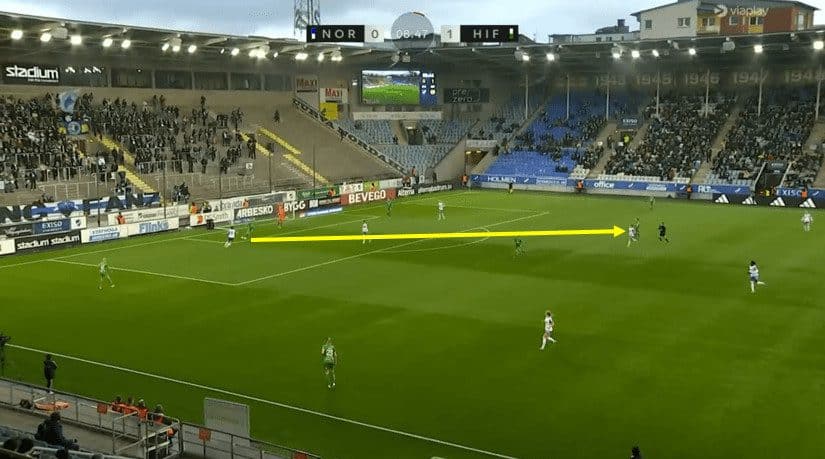
In the above example, you can see how the three Hammarby centre-backs are spread.
The wing-backs are holding the width on both flanks, and you have the two pivot options in the middle.
What you will notice in this example is how the opposition tries to deal with this problem.
They try to match up Hammarby’s back three with a front three, allowing them to manipulate the centre-backs to turn away from the right flank in possession.
However, this shape enables them to play through the middle as the opposition is forced to make a decision, and Hammarby will just target the free man.
In this case, she bites on Smilla Valotta and leaves Julia Roddar free to receive the ball.
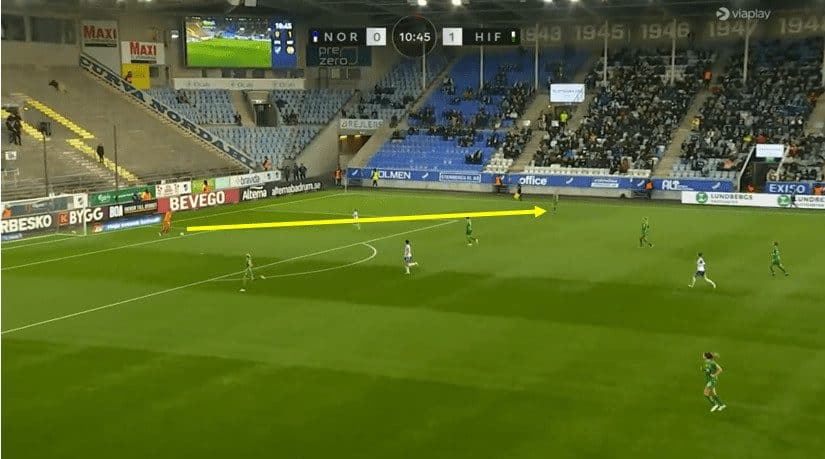
In the above example, the ball has been played back to the goalkeeper after the opposition plays a long ball, which is mopped up by the Hammarby backline.
In this case, the opposition tries to press the back three with just two players, and as such, Hammarby just plays the ball to the free central defender.
So, you can see that the build-up shape provides Hammarby with several solutions to combat different pressing styles by opponents.
Let’s look at what happens when the ball is moved higher up the field.
What tends to happen here is the centre-backs look to play penetrating passes towards the wingers who operate in the half spaces, then from there, they look to get the ball wide to the wing-backs who can cross the ball in from there.
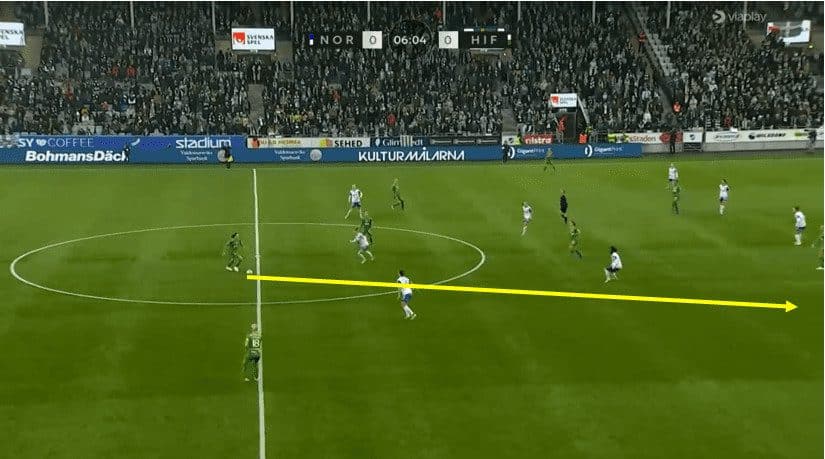
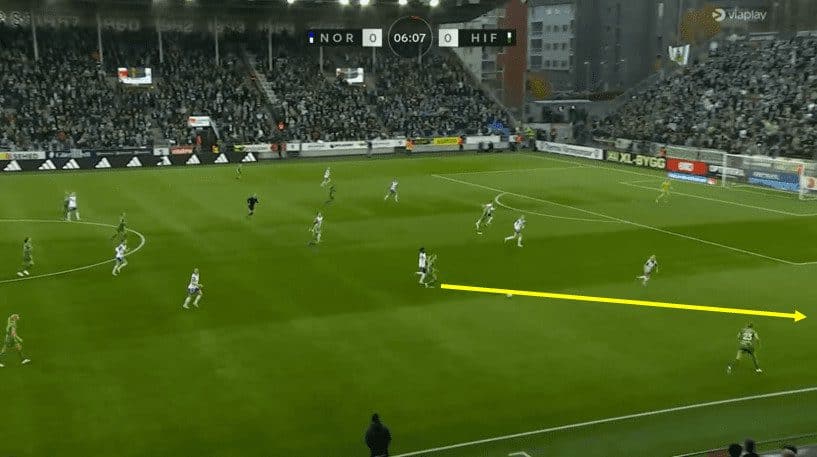
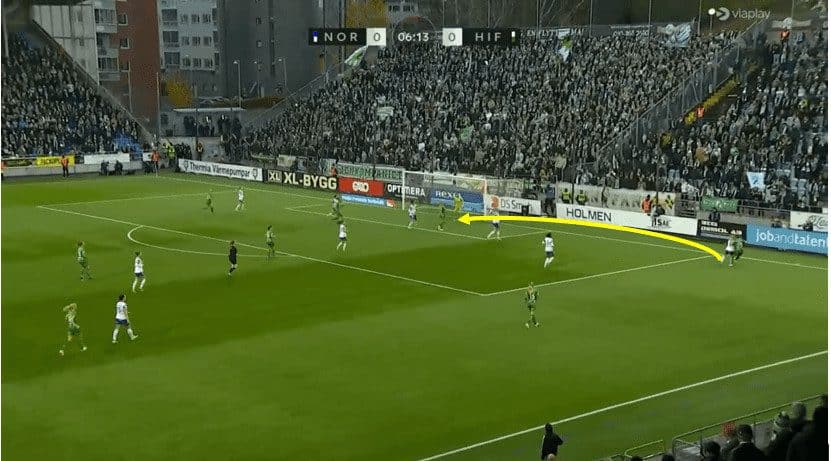
In the above example, you have Simone Sorenson on the ball initially in the middle of the defence.
Then, winger Matilda Vinberg drops to receive the ball in space.
She promptly turns and plays the ball into wing-back Emma Westin, who plays a low-whipped right-footed ball across the box, which is tapped in for a goal by Madelen Janogy.
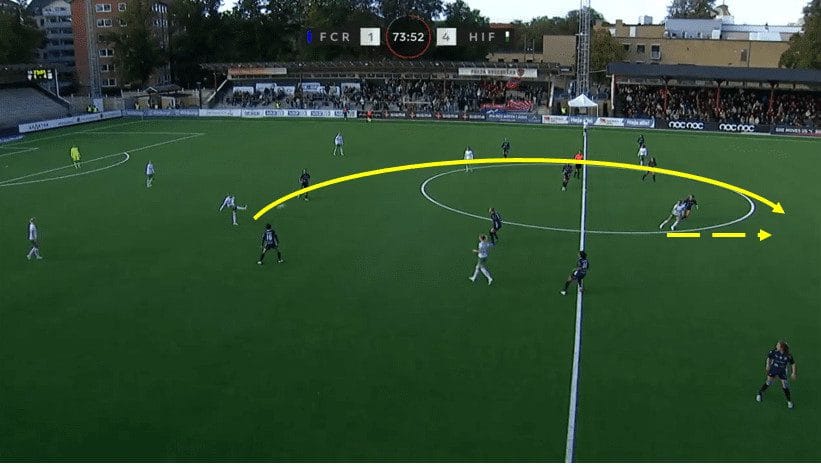
A significant reason that has enabled Hammarby to dominate field position so effectively is that they have real speed in behind, along the front line, and can cause all sorts of problems to back lines if they want to try and play a high defensive line.
In this example, it’s just a simple long ball played over the top by Smilla Valotta for Ellen Wangerheim to run onto, and she wins the race, and the ball eventually results in a goal for Janogy.
Having now looked at how Hammarby want to dominate the ball, let’s take a look at the situations where they thrive at scoring when they get the ball into the final third.
They finished the league season with the third highest xG per game at 2.23, only being beaten by BK Hacken(2.9) and Linkoping(2.64.) As many elite teams across world football, they look to take advantage of wide situations and score a large number of goals from first time finishes from crosses played across the box at the height of just below the knee.
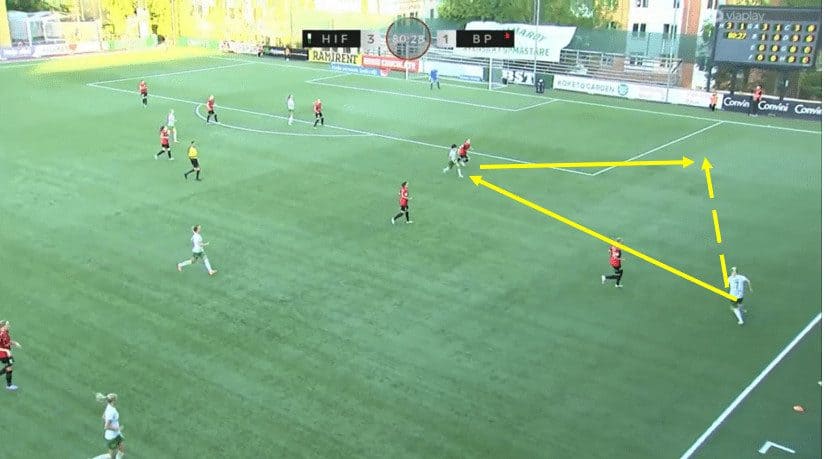
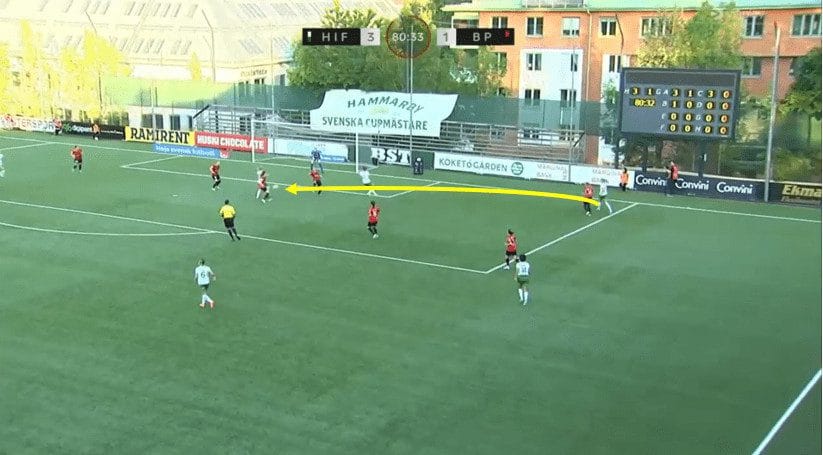
In this example, you have some nice dialogue with Maiko Hamino and wing-back Adelina Engman playing a 1-2 before a low right-footed cross is played into the box for a teammate to finish the first time.
Note the height of the ball is below the hip around the knee, and the ball is hit with the pace to beat opponents.
Pablo Piñones Arce Out of Possession
Hammarby looked to put pressure high up the field on their opponents, and this shows by the fact they finished the season in third when it pertains to high recoveries with 19.65 per 90.
Now, yes, although they wanted to press high up the field, Hammarby didn’t look to play a relentless tight man-to-man marking press where the opposition is in your face trying to win the ball back.
Instead, they operated a more calculated press where they looked to manipulate the opponents in possession and force them into traps, particularly by pushing them into wide areas where they trusted their ability to win 1v1 matchups or alternatively cut off options, forcing opponents to clear the ball long where their three central defenders could mop up any danger.
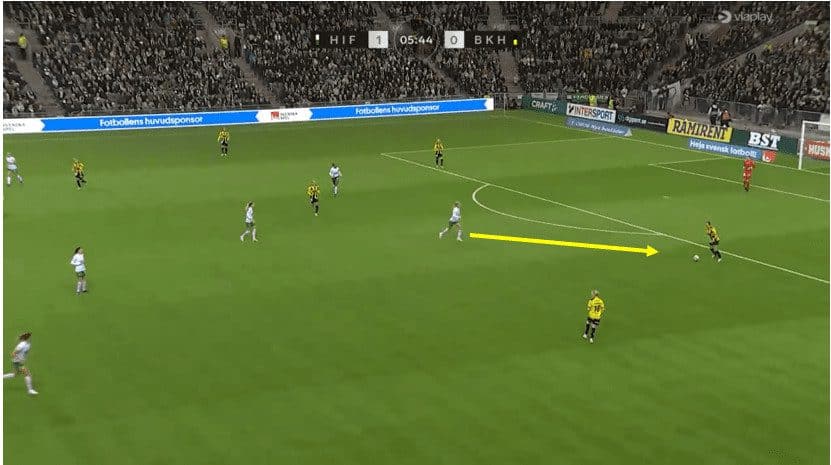

In this situation, Hammarby presses Hacken with a front two, and the forward Wangerheim presses the central defender from the inside, forcing her to go wide.
As this is going on, right wing-back Westin is alert and coming up to put pressure on the fullback as she receives the ball.
Interestingly, she forces the fullback to come inside, blocking out the wide channel.
The middle has been condensed by the Hammarby players, with the only real option being to switch the ball to the opposite flank, and in this, she is forced to play the ball backwards.
Hacken play a hopeful ball forward, which Hammarby deal with comfortably.
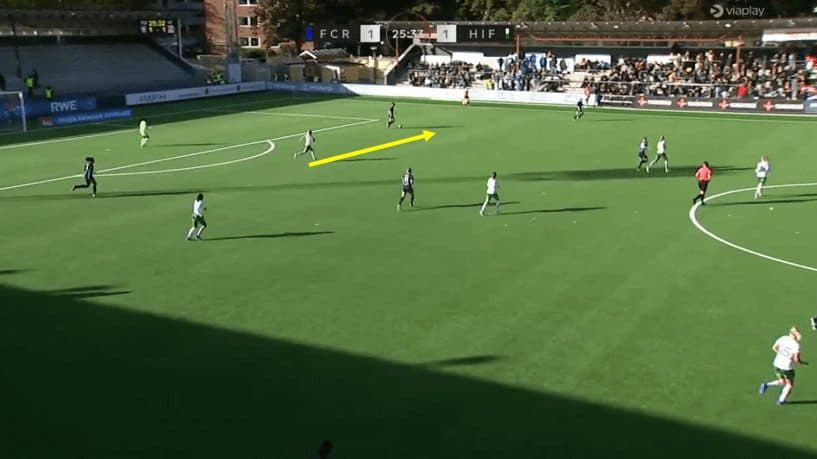
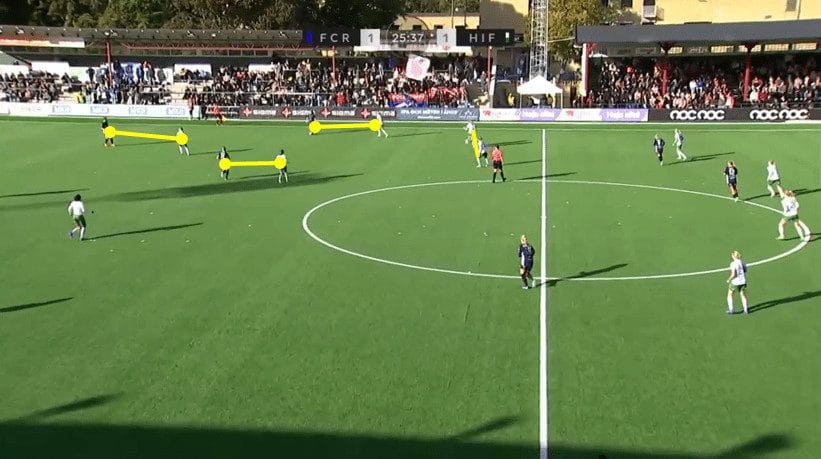
In this above example, you can see how the striker moves across the field following the ball while still cutting off the option to back where the ball came from, trying to pin them into this wide channel.
Then, when the ball is in the wide channel, the right wing-back has pushed up to put pressure on the ball.
Then, the two central midfielders have worked across to squeeze the space out of that wide channel.
Hamino, the attacking midfielder, then marks the opposition’s single pivot out of the game, thus leaving Rosenborg only one option: to go long where Hammarby can comfortably win the ball back.
Although Hammarby tended to dominate territory and possession during their games, they, like all times, had to find a way to defend when the opposition had prolonged periods of possession.
Hammarby did this by defending in a 1-5-2-2-1.
However, what would happen is the wing-backs stepped into midfield when the ball got into wide areas, which would create a lopsided-looking 1-4-3-2-1 shape.
The two wingers would play narrow and look to block passing lanes centrally; however, one of their primary roles was to be a quick and convenient option in transition.
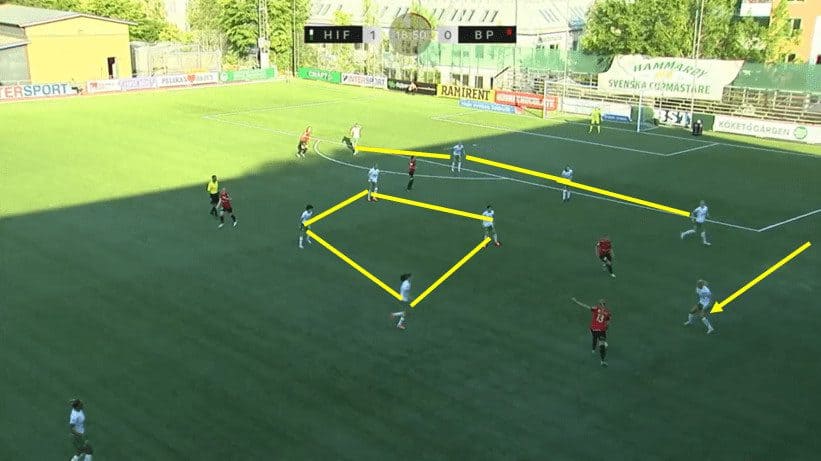
In the above example, you can see how Hammarby look to play with the back four shape.
You can see the two central midfielders sat just in front of the backline.
The wing-back has pushed up on the left side to put pressure on the ball carrier.
You can also see the two wingers playing narrow, creating a box midfield to eliminate the middle of the field.
Transition
Now Hammarby largely dominated possession and couldn’t take advantage of the broken field play associated with defence-attack transition.
They possessed some genuine speed threats with forward Madelen Janogy, who was able to demonstrate on several occasions how she can get in behind opposition defences.
Along with this, centre forward Ellen Wangerheim’s ability to hold the ball up with her back to goal allowed her to target coming out of transition.
As previously mentioned, with their defensive shape having the wingers playing narrow and therefore near to the midfielders, they were often in position to receive the ball quickly coming out of transition, enabling them to shift the ball away from condensed areas rapidly.

In this situation above, you can see how the ball is played into the centre forward Wangerheim, who is able to use her strength and size to hold up the ball and then rolls the defender and launches a counterattack at pace and is able to drive all the way into the box before taking a shot that she misconnects with and fails to score.


In this above example, you can see how Hammarby can play on the counter; with this example coming from the 2022 season against AIK, they win the ball back high into opposition territory and looks to play one of the wide players who is making a run into the wide channel she is able to receive the ball and drive forwards on the break.
Janogy can play off the shoulder of the last defender and receive the ball, leaving her through on goal 1v1 with the goalkeeper, where she can finish off effectively.
Hammarby operated a 1-3-2-5 shape in attack, with the two midfielders looking to support attacks in wide areas.
This could become an issue in attack-defence transition as it would often leave opponents attacking against solely a back three with spaces open to attack.

In this above example, a straightforward ball from deep takes out the entire Hammarby midfield and the right wing-back, creating an instant 3v3 which the opposition is able to score from.
Note how easily they are left exposed for numbers at the back.

In the above example, you can see how Hammarby pushes bodies into advanced positions when in attack.
So when Hacken wins the ball back, it takes one pass into the centre forward, and the midfield is now 20m out of position.
Then the centre-back steps out of the defence to put pressure on the striker, who can turn and play a forward pass to the onrushing winger who can get behind the defence.
In this case, the central defender does superbly to delay the winger 1v1 and keep her wide until she has some help from her recovering defenders.
Pablo Piñones Arce Strengths
The greatest weapons to Hammarby were their ability to control the ball and create goal-scoring situations in doing so.
In particular, their best asset was their ability to get crosses in from wide areas, particularly from the right flank, where the wing-backs could play low-whipped crosses below the knee for one-touch finishes for forward players to attack.
Hammarby often has three forward players in the box to attack the ball.
Another strength of the Hammarby side was their ability to score from set pieces, which they did to significant effect throughout the season but particularly at critical points at the back end of the season.


Hammarby drew Hacken out with a short corner option, taking two defenders out of the box.
Then the four players at the edge of the box are going to make runs, Alice Carlsson and Vinberg, making runs towards the front post where the ball is played.
These two players, combined with Wangerheim, who starts on the edge of the 6-yard box, create the uncertainty that Hammarby are trying to create, and Janogy is able to react first to a ricocheting ball in the box and finishes the goal off.

Similarly to the previous example, Hammarby is going to try and create uncertainty in the box by packing players into the 6-yard area.
In this case, Hamano makes a run towards the taker to draw the defender out of the box.
The ball is crossed with an inswinging delivery into this congested area, and Hammarby is able to deal with a ricocheting ball better than their opponents and score a goal.


Hammarby can combine this ability to create uncertainty at set pieces by then adjusting to their opponents.
In this example, Hammarby has identified that their opponents, Brommapojkarna, are migrating to the front post area, so instead, Hammarby play a deeper ball to the back post, where they are again able to finish the chance off.
Pablo Piñones Arce Weaknesses
The biggest weakness for the Hammarby side was how exposed they could leave themselves if they lost the ball high up the field.
With so many players in attacking positions and mainly how they tried to condense particular areas of the field to create overloads, this could leave significant gaps in the midfield for opponents to target quickly coming out of a defence-attack transition.

In this above example, you can see the massive disconnect between the defensive line and the midfield that leaves the attacking midfielder for the opposition all this room to potentially work in.
However, the inside option is cut off nicely by the body shape of the left wing-back.


In this above example, Hammarby has just lost the ball in possession with the ball at the winger’s feet.
You will notice how many Hammarby players are condensed onto one side of the field in an attempt to overload it in attack.
However, having lost the ball one quick pass, they have left themselves exposed to the opposition counterattack, leaving all this space to run into.
Another aspect they struggled to deal with was when teams could match up with their midfielders centrally in the build-up; take the game against Hacken, for example.
Hammarby generally look to play out from the back using their centre backs and then playing balls into the two central pivots that they have; however, when Hacken was eliminated, they had less joy playing out from the back as Hacken were able to win the ball back high up the field a couple of times.


Above, you can see Hacken can cut off the Central defender’s options with her body shape, forcing her to play down the flank.
Hacken is then able to match up the Hammarby player for player, and as such, Hammarby try to force the ball into the midfield as they lack a more direct option against the top sides to get them out of jail.
Conclusion
As you can see, Hammarby were a fascinating team to watch and, throughout the season, was one of the leading teams in the Damallsvenskan.
Down the stretch in the big games at the end of the season, Hammarby could pick up some significant wins, such as the 3-2 win against Hacken to pip them to the post and on the balance of play throughout the season, they fully deserved to do so.






Comments